
Bayonne is a city in southwestern France. It is a commune and one of the two sub-prefectures of the department of Pyrénées-Atlantiques, in the Nouvelle-Aquitaine region. It is located at the confluence of the Nive and Adour rivers in the northern part of the cultural region of the Basque Country. Bayonne is alongside Biarritz the seat of the CA Pays Basque. This is also the southern part of Gascony, where the Aquitaine basin joins the beginning of the Pre-Pyrenees.
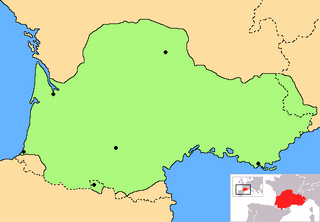
Occitan, also known as lenga d'òc by its native speakers, and sometimes also referred to as Provençal, is a Romance language spoken in Southern France, Monaco, Italy's Occitan Valleys, as well as Spain's Val d'Aran; collectively, these regions are sometimes referred to as Occitània. It is also spoken in Southern Italy (Calabria) in a linguistic enclave of Cosenza area. Some include Catalan in Occitan, as the distance between this language and some Occitan dialects is similar to the distance between different Occitan dialects. Catalan was considered a dialect of Occitan until the end of the 19th century and still today remains its closest relative.
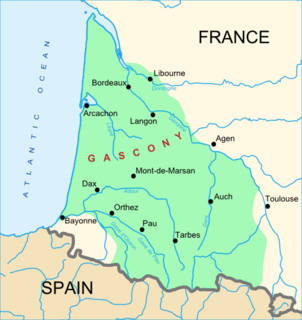
Gascony was a province of southwestern France that succeeded the Duchy of Gascony. From the 17th century until the French Revolution, it was part of the combined Province of Guyenne and Gascony. The region is vaguely defined, and the distinction between Guyenne and Gascony is unclear; by some they are seen to overlap, while others consider Gascony a part of Guyenne. Most definitions put Gascony east and south of Bordeaux.

Pyrénées-Atlantiques is a department in the southwest corner of France and of the region of Nouvelle-Aquitaine. Named after the Pyrenees mountain range and the Atlantic Ocean, it covers the French Basque Country and the Béarn. Its prefecture is Pau. In 2019, it had a population of 682,621.

Gascon is the name of the vernacular Romance variety spoken mainly in the region of Gascony, France. It is often considered a variety of Occitan, although some authors consider it a different language.

Midi-Pyrénées is a former administrative region of France. Since 1 January 2016, it has been part of the new region of Occitania. It was the largest region of Metropolitan France by area, larger than the Netherlands or Denmark.
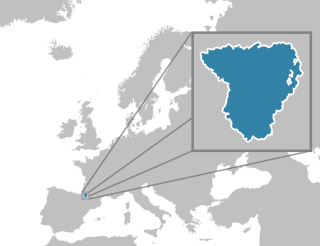
The Béarn is one of the traditional provinces of France, located in the Pyrenees mountains and in the plain at their feet, in southwest France. Along with the three Basque provinces of Soule, Lower Navarre, and Labourd, the Principality of Bidache, as well as small parts of Gascony, it forms in the southwest the current département of Pyrénées-Atlantiques (64). The capitals of Béarn were Beneharnum, Morlaàs, Orthez, and then Pau.

Occitania is the historical region in Western and Southern Europe where Occitan was historically the main language spoken, and where it is sometimes still used, often as a second language. This cultural area roughly encompasses the southern third of France, as well as part of Spain, Monaco, and smaller parts of Italy. Occitania has been recognized as a linguistic and cultural concept since the Middle Ages, but has never been a legal nor a political entity under this name. However, the territory was united in Roman times as the Seven Provinces and in the Early Middle Ages.
Niçard, nissart/Niçart, niçois, or nizzardo is the dialect that was historically spoken in the city of Nice, in France, and in all the area of the historical County of Nice. The affiliation of Niçard is debated: it is generally considered a subdialect of Provençal, itself a dialect of Occitan, while some scholars argue that the historical dialect spoken in Nice was more strictly Ligurian.
Meridional French, also referred to as Francitan, is a regional variant of the French language. It is widely spoken in Marseille, Avignon and Toulouse and is influenced by the Occitan language.

The Landes forest in the Landes de Gascogne, in the historic Gascony natural region of southwestern France now known as Aquitaine, is the largest man-made woodland in Western Europe. The French word, landes and Gascon lanas, mean 'moors' or 'heaths', from Transalpine Gaulish *landa ; compare Irish lann, Welsh llan (“enclosure”).

The Occitano-Romance or Gallo-Narbonnese, or rarely East Iberian, is a branch of the Romance language group that encompasses the Catalan/Valencian and Occitan languages spoken in parts of southern France and northeastern Spain.

The course landaise is an ancient form of bullfighting and bull-leaping held in oval or rectangular arenas covered in sand, that involves no bloodshed. Experienced cows, with large horns, aged generally from 2 to 14 years old, are used instead of bulls. They are athletic but small animals selected from the same breed as the bulls used for the Spanish corridas. In Gascony, it is a major spectator sport, counting as many as 600 events each year.
This article describes the phonology of the Occitan language.

Occitania is the southernmost administrative region of metropolitan France excluding Corsica, created on 1 January 2016 from the former regions of Languedoc-Roussillon and Midi-Pyrénées. The Council of State approved Occitania as the new name of the region on 28 September 2016, coming into effect on 30 September 2016.

The cuisine of Gascony is one of the pillars of French cuisine. Its originality stems from its use of regional products and from an age-old tradition, typical of the Aquitane and the Midi-Pyrenees, of cooking in fat, in particular goose and duck fat, whereas the cuisine of the south of France favours frying in oil and the cuisine of Normandy contains more dishes that are simmered or cooked in butter. The long life expectancy of Gascons, despite a rich diet, is a classic example of the French paradox.
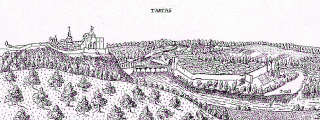
The siege of Tartas in Gascony was an engagement between English and French forces in the late stages of the Hundred Years' War. It was undertaken by English forces and their Gascon subjects against Charles II of Albret, a powerful nobleman in southwestern France. Albret was hostile to the English and his presence in Gascony caused much trouble to the English in the region, thereby raising the need to strike against him. The bulk of hostilities only lasted up until early 1441: the siege had dragged on inconclusively, and peace terms were agreed between the attackers and defenders. The ceasefire was extended several times until mid-1442 as both sides awaited further support from England and France.

Gaillard III de Durfort was a Gascon nobleman of the Durfort family. He inherited the lordship of Duras and Blanquefort from his father, Gaillard II, in 1422. In the Hundred Years' War between England and France, Gaillard took the side of the English king, who was the feudal suzerain of Gascony.
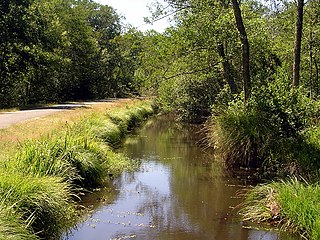
The Landes de Gascogne, or Gascony Moors, is a natural region of France of nearly 14,000 km2 (5,400 sq mi). It extends over three departments: Gironde, Landes and Lot-et-Garonne, and includes 386 communes. The region is a flat, sandy plain in the west of the Aquitaine Basin beside the Atlantic Ocean. The interior is cut off from the sea by a barrier of dunes. It is dominated by pine forests that cover 66% of the territory, with islets of agriculture over 18% of the territory.
Judeo-Gascon is a sociolect of the Gascon language, formerly spoken among the Spanish and Portuguese Jews who settled during the 16th century in the cities of Bordeaux, Bayonne and in the south-west part of Landes of Gascony (most notably in Peyrehorade and Bidache. Judeo-Gascon, as Judeo-Provençal, the other major Jewish sociolect of Occitan, is now practically extinct.















